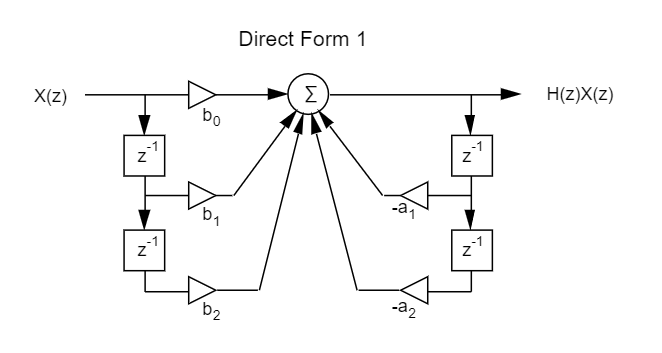I heard that the Direct form II transposed is better for floating-point and the Direct form I is better for fixed-point. Is it true?
Mostly yes. DF1 is a perfectly good choice for floating point too. The only minor downside it that DF1 has twice the number of state variables than TF2. However if you implement cascaded biquads (which is the most common implementation), subsequent DF1 stages can share state variables. For example a 8-biquad filter needs 16 state variables in TF2 and 18 (not 32) state variables in DF1, if it's written properly.
The final result y(n) is in range.
That is an invalid argument. Regardless of topology, you have to manually scale your filter so that the output doesn't clip. DF1 offers no advantage here at all since all topologies produce the same output. In the following we will assume that the filter is already scaled not to clip the output.
There is fundamentally only one summation point in the filter
That's not wrong but still missing the point.
This is all about state variables. State variables are information that you need to store so it can be used in the calculation of the next sample, i.e. they implement the delays.
Every time you store something in memory you will have to truncate to a finite world length. That creates noise and you also need to make sure that you don't overflow.
The ONLY state variables that DF1 has are it's inputs and outputs. So if you have already made sure that your output doesn't clip, none of the state variables can clip.
Most fixed point processors used an wider word width for intermediate calculations (often referred to as "accumulator") , so clipping during the actual math is less of a concern.
TF2 has one internal state variable, and you would have to calculate the transfer function from the input to the state variable to determine whether it may clip or not. So you end up with one extra scaling step which isn't trivial to do in both analysis and implementation.
For TF2 the gain between input and state is "bounded", i.e. it cannot exceed a certain value (which I'm currently too lazy to calculate, maybe 6 or so?) that's reasonable regardless of the filter coefficients.
TF1 and DF2 are very bad since the gain is unbounded and highly dependent on the filter coefficients. Flor typical audio filters, it's not unusual to see a gain that exceeds 100 dB or more. ! This can be a real problem, even for 32-bit floating point.

